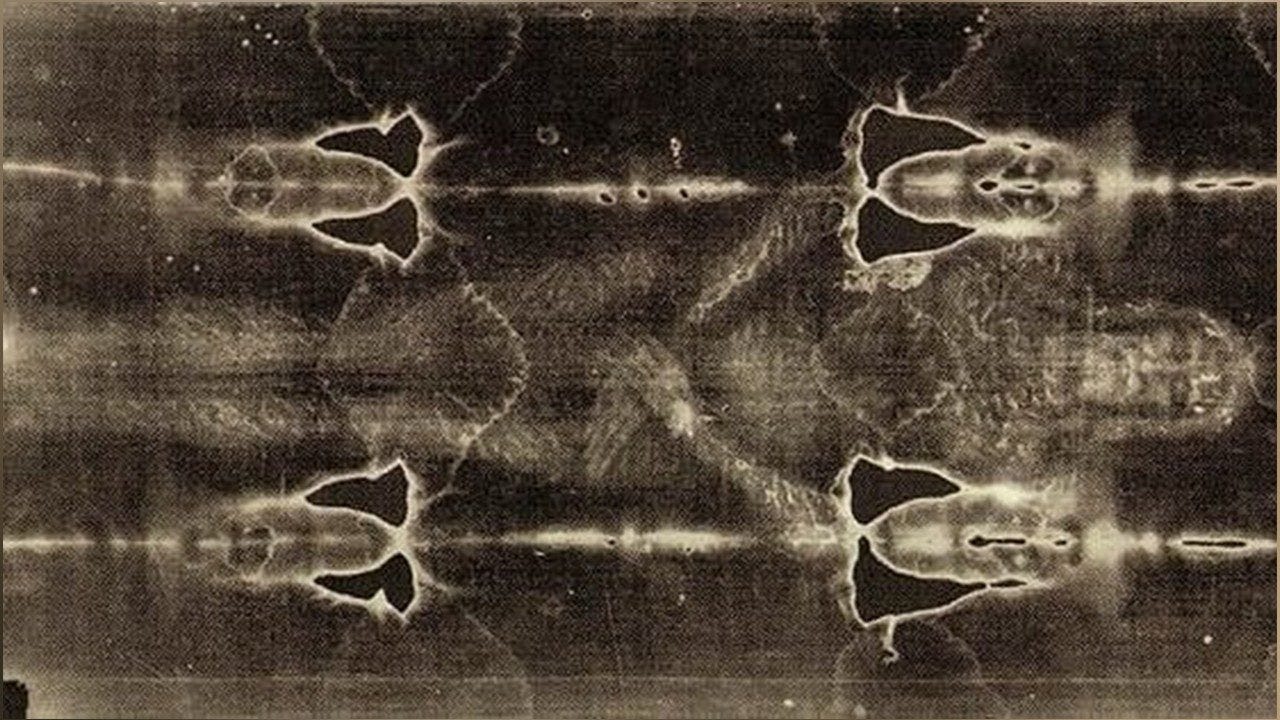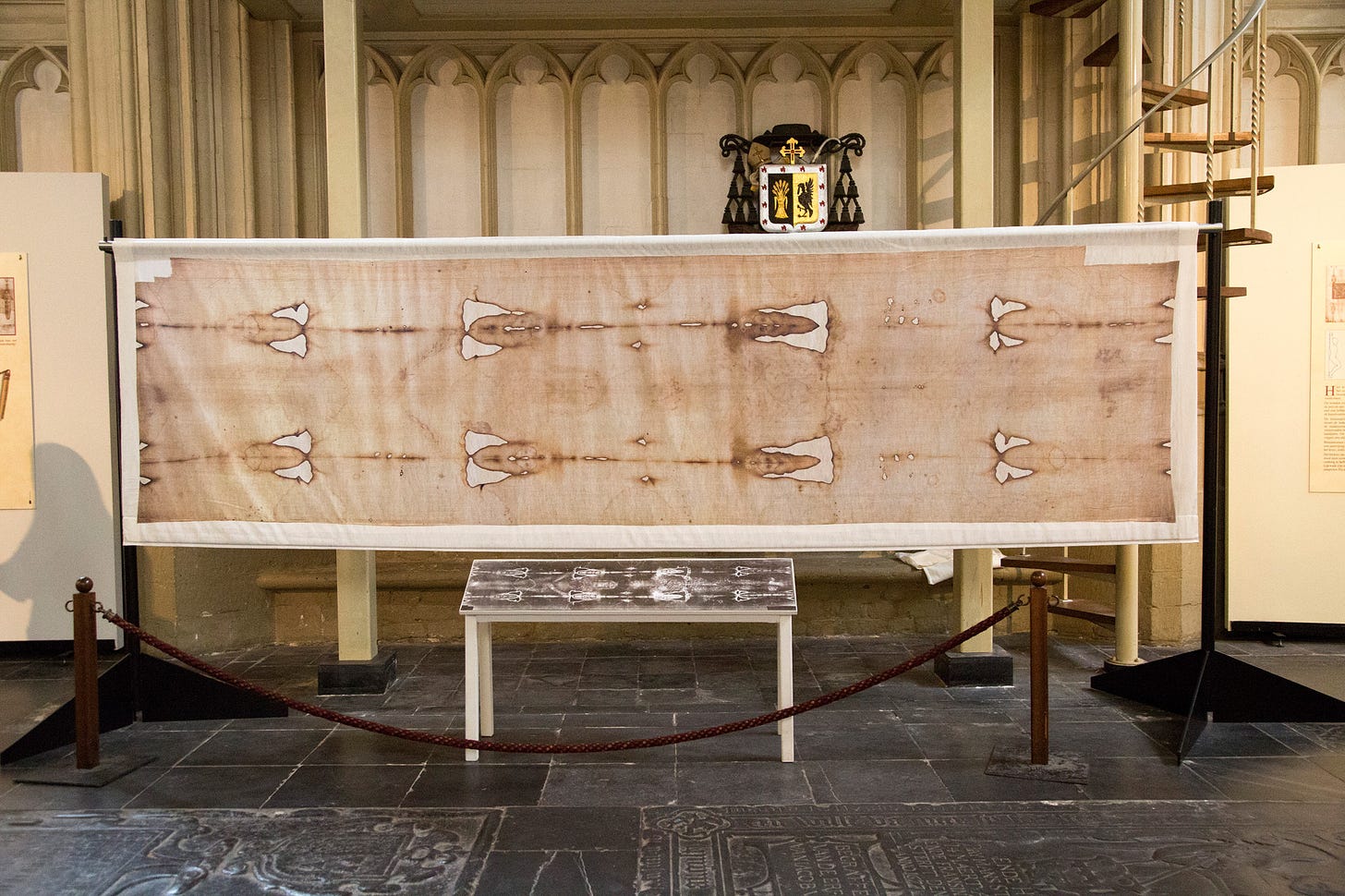October 13 - The Shroud of Turin and the Controversial Carbon Test
Avoiding Idolatry: Worshipping God, Not Objects
This is the day in 1988 when carbon-dating tests revealed that the Shroud of Turin, revered by many Christians as Christ's burial cloth, was likely a medieval creation rather than an ancient artifact.
In today's lesson, we explore the delicate balance between faith and physical evidence. How do we navigate the tension between revering religious artifacts and maintaining a pure, unmediated relationship with God? Join us as we unpack the spiritual implications of the Shroud of Turin's carbon dating and reflect on the nature of true worship.
"You shall not make for yourself an image in the form of anything in heaven above or on the earth beneath or in the waters below. You shall not bow down to them or worship them; for I, the Lord your God, am a jealous God..." - Exodus 20:4-5 (NIV)
This Date in History
On October 13, 1988, in the hallowed halls of the British Museum, a group of scientists huddled around a computer screen, their faces illuminated by its soft glow. The tension was palpable as they awaited the results that would shake the foundations of faith and science alike. The subject of their scrutiny? A piece of ancient linen that had captivated the world for centuries - the Shroud of Turin.
The Shroud of Turin first emerged into recorded history in the mid-14th century in Lirey, France. This 14-foot-long linen cloth bears the faint image of a bearded man with wounds consistent with crucifixion, igniting fervent belief that it was the actual burial shroud of Jesus Christ. Its appearance coincided with a medieval fascination with religious relics, objects believed to have a direct connection to holy figures or events.
For the Catholic Church, such venerated objects held immense spiritual significance. Relics were seen as tangible links to the divine, capable of working miracles and drawing the faithful closer to God. The Shroud, with its haunting image seemingly imprinted by supernatural means, became one of the most revered and controversial of these relics.
As the centuries passed, the Shroud's journey was marked by both veneration and skepticism. It survived fires, wars, and countless hands that sought to unlock its secrets. In 1578, it found its permanent home in Turin, Italy, where it has since been guarded and preserved by the Catholic Church.
As the 20th century dawned, new scientific methods were brought to bear on the ancient cloth. In 1898, Secondo Pia's photographs revealed that the image on the Shroud was actually a negative, intensifying both mystery and debate. Subsequent studies examined the cloth's weave, the pollen trapped in its fibers, and the peculiar properties of the image itself. Some findings seemed to support its authenticity, while others cast doubt.
In the 1940s a technique was developed that revolutionized archaeology - radiocarbon dating. By measuring the decay of carbon-14 isotopes in organic materials, scientists could determine their age with unprecedented accuracy. However, the method is not without its limitations. Contamination of samples, variations in atmospheric carbon levels over time, and the effects of extreme heat or radiation can all potentially skew results.
In 1988, after years of negotiation, the Vatican allowed a small sample of the Shroud to be tested using this method. Laboratories in Oxford, Zurich, and Arizona were tasked with this monumental undertaking. As the scientists in the British Museum awaited the final compilation of results, the weight of history pressed upon them.
The verdict, when it came, was stunning. All three labs independently dated the cloth to between 1260 and 1390 AD - squarely in the medieval period, well over a millennium after the time of Christ. The announcement sent shockwaves through both scientific and religious communities.
Believers were shaken, skeptics vindicated. The Catholic Church, while respecting the results, maintained a nuanced position. Cardinal Anastasio Ballestrero of Turin stated that while the church accepted the reliability of the testing, the mystery of the image remained unexplained.
In the years following, the debate raged on. Some researchers questioned whether the tested sample truly represented the whole shroud, suggesting it might have been from a medieval repair. Others pointed to potential contamination or the effects of a fire the Shroud survived in 1532 as factors that could have skewed the results.
Further scientific investigations continued. In 2002, the Shroud underwent a restoration process, removing patches and a backing cloth added in 1534. This process revealed a previously hidden part of the burial cloth, showing a side strip and seam that some argued was typical of first-century Jewish burial shrouds.
Subsequent studies have examined the Shroud using advanced imaging techniques, analyzed the chemical composition of the image, and even attempted to recreate the image using methods available in medieval times. Each new study has added layers to the mystery, often raising as many questions as they answer.
Today, the Shroud of Turin rests in the Cathedral of Turin, rarely displayed to the public. Its last major exhibition was in 2015, drawing millions of pilgrims from around the world. Despite - or perhaps because of - the carbon dating results, it continues to fascinate both believers and skeptics alike.
The 1988 carbon dating of the Shroud of Turin stands as a testament to the complex interplay between faith, science, and history. It reminds us that in the quest for truth, every answer often leads to new questions, and that some mysteries continue to captivate the human imagination across centuries.
Historical Context
The carbon dating of the Shroud of Turin in 1988 took place during a period of rapid technological advancement and shifting paradigms in both scientific and religious spheres. The late 20th century witnessed a surge in the precision and acceptance of scientific dating methods, particularly in archaeology. Radiocarbon dating, introduced in the 1940s, had become a cornerstone in determining the age of organic artifacts, revolutionizing our understanding of historical timelines.
This era also marked a transformative period in the relationship between religious institutions and the scientific community. Pope John Paul II, who began his papacy in 1978, had been actively working to bridge long-standing divides between faith and science. His efforts to reconcile the Church's historical stance on scientific matters, such as the re-examination of the Galileo affair initiated in 1979, signaled a new era of openness to scientific inquiry within religious contexts.
The 1980s saw a surge in public fascination with the intersection of science and faith. Media outlets frequently featured stories about archaeological discoveries related to biblical events, fueling both excitement and controversy. This period was characterized by the rise of both religious fundamentalism and secular skepticism, creating a charged atmosphere for any findings related to religious artifacts.
In academic circles, there was ongoing debate about the historical Jesus and the reliability of physical evidence related to early Christianity. The Shroud of Turin had long been a focal point of this discussion, with various scientific studies throughout the 20th century yielding conflicting results and interpretations.
The decision to allow carbon dating of the Shroud came after years of careful negotiation between the Catholic Church and the scientific community. It represented a significant moment of collaboration, reflecting the complex dynamics of faith and reason in the late 20th century.
Globally, the late 1980s were a time of significant geopolitical change. The Cold War was nearing its end, and new technologies were beginning to reshape global communication. These broader contexts influenced how the findings about the Shroud were disseminated and interpreted across different cultures and belief systems.
The carbon dating of the Shroud of Turin thus occurred at a unique historical juncture, where advancements in scientific capabilities intersected with evolving religious attitudes and global communication patterns. This set the stage for an event that would resonate far beyond the realms of archaeology and religion, challenging long-held beliefs and sparking new dialogues about the nature of faith and evidence.
Did You Know?
The first documented exhibition of the Shroud was in Lirey, France, around 1355, by a French knight named Geoffroi de Charny.
Today’s Reflection
The revelation that the Shroud of Turin, long venerated as the burial cloth of Jesus, likely dates from medieval times serves as a powerful reminder of the dangers inherent in attaching too much importance to physical objects in our spiritual lives. This carbon dating result challenges us to examine our own faith practices and ensure that we're not inadvertently slipping into patterns of idolatry.
Throughout history, humans have demonstrated a persistent tendency to seek tangible representations of the divine. We seem to crave something we can see, touch, or hold onto as an anchor for our faith. This inclination is understandable; in a world full of uncertainty, having a physical object to focus our devotion on can feel comforting and concrete. Yet, it's precisely this impulse that God warns against in our scripture for today: "You shall not make for yourself an image in the form of anything in heaven above or on the earth beneath or in the waters below. You shall not bow down to them or worship them; for I, the Lord your God, am a jealous God..." Exodus 20:4-5 (NIV)
This commandment, one of the fundamental tenets of faith given to Moses, explicitly prohibits the creation and worship of idols. But why is God so adamant about this? The answer lies in the nature of our relationship with Him. God desires a direct, personal connection with each of us. When we begin to focus our worship on objects, even those purportedly connected to holy events or figures, we risk placing a barrier between ourselves and God. We may start to associate God's presence or power with the object itself, rather than recognizing His omnipresence and sovereignty over all creation.
The Bible is replete with examples of the dangers of idolatry. From the golden calf crafted by the Israelites in the wilderness (Exodus 32) to the household gods of Laban that Rachel stole (Genesis 31:19), we see time and again how easily people can be led astray by physical representations of the divine. Even objects originally intended to honor God, like the bronze snake Moses made to heal the Israelites, eventually became objects of misplaced worship and had to be destroyed (2 Kings 18:4).
It's important to approach this topic with understanding, recognizing that the desire to connect with the divine through tangible means often comes from a place of sincere devotion. Many throughout history have sought to express their faith through physical objects or practices. However, we must heed the clear biblical warnings against allowing any object to become a substitute for direct worship of God. Our ultimate focus should always be on cultivating a personal relationship with the living God, rather than on any physical representation or relic.
In the case of the Shroud of Turin, regardless of its true origins, the danger lies not in appreciating it as a historical artifact or even in being moved by its imagery. The problem arises when such an object becomes a focus of veneration in itself, potentially distracting from or replacing direct worship of God. The apostle Paul, addressing the intellectual Athenians, emphasized this point: "The God who made the world and everything in it is the Lord of heaven and earth and does not live in temples built by human hands." Acts 17:24 (NIV) This reminds us that God's presence isn't confined to or dependent on any physical location or object. He is spirit, and true worship of Him must be in spirit and in truth (John 4:24).
As we reflect on the Shroud of Turin and its carbon dating, let's use this as an opportunity to examine our own faith practices. Are there any objects or images that we've allowed to take too central a role in our spiritual lives? Have we inadvertently begun to associate God's presence more with certain places, items, or rituals than with His omnipresent spirit? Let's challenge ourselves to strip away any barriers we may have erected between ourselves and God, even unintentionally.
Instead of seeking God through physical objects, let's focus on cultivating a direct, personal relationship with Him through prayer, study of His Word, and living out our faith in active service and love. Remember, the most profound evidence of God's presence in our lives isn't found in relics or images, but in the transformation of our hearts and the fruit of the Spirit manifest in our actions.
In a world that constantly seeks tangible proofs and visible signs, let's be a people who walk by faith, not by sight (2 Corinthians 5:7). Our testimony to the world should be the living reality of Christ in us, not our attachment to physical objects, no matter how historically or artistically significant they may be. Let our focus always be on the invisible but ever-present God, who is able to do immeasurably more than all we ask or imagine (Ephesians 3:20).
Author's Note: I am aware that the Shroud of Turin remains a subject of ongoing debate, with studies and examinations supporting various viewpoints beyond the 1988 testing. Today's lesson focuses on that specific carbon dating event and its immediate impact. However, I encourage you to consider Today’s Reflection in which the core message of our lesson invites us to consider a broader spiritual truth: that the authenticity of physical relics, while historically interesting, should not be the foundation of our Christian faith and practice.
Practical Application
Conduct a personal inventory of your faith practices. Identify any physical objects, locations, or rituals that you might be relying on too heavily in your spiritual life. Challenge yourself to spend a week focusing solely on direct communication with God through prayer and Scripture reading, without the use of any physical aids or specific locations. Reflect on how this experience impacts your sense of God's presence and your understanding of worship.
Closing Prayer
Heavenly Father, we thank You for Your desire to have a direct, personal relationship with each of us. Help us to recognize and remove any idols in our lives, whether physical objects or intangible things that we've placed before You. Strengthen our faith to worship You in spirit and in truth, relying not on what we can see or touch, but on Your unchanging Word and presence. Guide us to a deeper, more authentic relationship with You that transforms our hearts and actions. In Jesus' name, we pray. Amen.
Supplementary Study
"Those who cling to worthless idols turn away from God's love for them."
This verse powerfully illustrates the consequence of idolatry: it separates us from God's love. In the context of our lesson, it reminds us that when we place undue importance on relics or objects, even those with religious significance like the Shroud of Turin, we risk turning away from the true source of divine love and grace.
"For although they knew God, they neither glorified him as God nor gave thanks to him, but their thinking became futile and their foolish hearts were darkened. Although they claimed to be wise, they became fools and exchanged the glory of the immortal God for images made to look like a mortal human being and birds and animals and reptiles."
This passage from Romans describes the progression from knowing God to falling into idolatry. It highlights how even those who have knowledge of God can gradually shift their focus to created things rather than the Creator. This relates to our lesson by showing how easy it is to slip into venerating objects or images, even when starting from a place of genuine faith.
"Do not turn to idols or make metal gods for yourselves. I am the Lord your God."
This direct command from God emphasizes His exclusivity in our worship. It reminds us that creating or turning to any form of idol – whether a physical object like the Shroud or even mental constructs – goes against God's desire for our undivided devotion. This verse reinforces our lesson's main point about maintaining a direct, unmediated relationship with God.
Final Thoughts
The carbon dating of the Shroud of Turin serves as a powerful reminder that our faith should not be anchored in physical objects, no matter how compelling or historically significant they may seem. While artifacts and relics can hold historical and cultural value, they should never become the focus of our worship or the foundation of our belief. True faith transcends the tangible, resting instead on the unchanging nature of God and His Word. As we navigate our spiritual journeys, let us always strive to worship God in spirit and in truth, keeping our hearts free from any form of idolatry and fixed firmly on the living God who desires a personal relationship with each of us.
Community Engagement
Share your thoughts or use these questions to get the conversation started.
What was your initial reaction to learning about the carbon dating results of the Shroud of Turin?
In what ways might we unintentionally allow physical objects or practices to become idols in our spiritual lives?
How can we balance appreciating historical religious artifacts while ensuring they don't become objects of veneration?
What practical steps can we take to deepen our direct relationship with God, independent of physical aids or locations?
This devotional is free to read. You can support this publication by becoming a subscriber, upgrading to paid subscriber status, liking this post, commenting, and/or sharing this post with anyone who might enjoy it.
In tomorrow's lesson, we'll delve into a moment of extraordinary courage that changed the course of history. Prepare to be inspired by a tale of resilience that challenges us to view our own struggles through a lens of purpose and hope.
Bonus - Did You Know?
The Shroud of Turin survived a fire in 1532 that left scorch marks and holes, which were repaired by Poor Clare nuns.
In 1898, Secondo Pia took the first photographs of the Shroud and discovered that the image on the cloth was actually a negative, sparking renewed scientific interest.
The Shroud's image shows a man with a height of about 5'11" to 6'2", which was unusually tall for a first-century Judean man.
Pollen grains found on the Shroud include several species native to the Middle East, which some argue supports its authenticity.
The blood stains on the Shroud are real human blood, specifically type AB, which is relatively rare.
Despite the carbon dating results, the exact method by which the image on the Shroud was created remains a mystery to scientists.
Additional Resources
Shroud of Turin: The Burial Cloth of Jesus Christ? - Ian Wilson
The Turin Shroud: In Whose Image? - Lynn Picknett and Clive Prince
The Sign: The Shroud of Turin and the Secret of the Resurrection - Thomas de Wesselow
The Truth About the Shroud of Turin: Solving the Mystery - Robert K. Wilcox











More recent testing suggests the contrary - there are abundant articles on the internet - here's the first one that came up on DuckDuckGo: https://www.thearchaeologist.org/blog/new-findings-reinforce-the-authenticity-debate-of-the-turin-shroud - the gist of the articles says the current method of analysis was not available forty years ago and the current method (which compares the shroud’s cellulose degradation with that of other linens discovered in Israel dating back to the first century) found "the data profiles were consistent with linen samples dated between 55 and 74 AD, such as those found at Masada, Israel, Herod's ancient fortress overlooking the Dead Sea."
After Jesus' resurrection, after Jesus had told Thomas to touch his wounds, he said this to Thomas: “You believe because you have seen me. Blessed are those who believe without seeing me.” (John 20:29 NLT) The natural world always wants some kind of physical proof of everything, but following Jesus is a walk of faith. Thus, God has called us to live by "believing and not by seeing." (2 Corinthians 5:7 NLT)